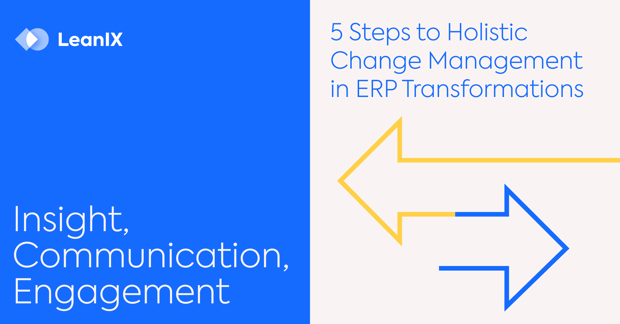
ERP transformation touches all the moving parts of your organization, including your people. Learn how empowering your enterprise architecture can also master the change management aspects of upgrading your ERP system.
Enterprise resource planning (ERP) transformation is a challenging prospect. Replacing your software is difficult enough, but upgrading your ERP system involves a total business transformation across all the operations that your ERP platform interfaces with.
To complete your transformation, you're going to need buy-in and support from people across your whole organization, and that requires a change management program. The secret to ERP transformation success through change management, however, is using enterprise architecture to align your new technology with your teams' business goals.
To dive deeper into how you can leverage change management to succeed in ERP transformation, download our free white paper:
WHITE PAPER - Insight, Communication, Engagement: How EA Supports Change Management
The Missing Link in ERP Transformation
Your Enterprise resource planning (ERP) platform is the nervous system of your organization. From hiring key talent and acquiring office estate, to managing the activities of a production line worker, your ERP system is integrated with every part of your organization.
Just as a human's capabilities are compromised if their nervous system is damaged, an aging ERP platform can hold your organization back from achieving its strategic vision. Yet, replacing it can seem as complex as surgically transplanting a human nervous system.
The secret to success here is to democratize the process. Rather than having to understand how hundreds of processes connect your ERP system in hundreds of ways, you can allow the people who run those processes every day to tell you how they work and how they can be optimized with a more-powerful ERP tool.
Doing this means documenting and mapping your ERP estate and how it connects to your application portfolio. Then, you'll need to consult with key stakeholders across your organization to gain the vital intelligence you need to road map out a plan for ERP transformation.
This is vital for overcoming the key challenges that are holding companies back from the competitive advantages they could gain from leveraging a modern ERP platform. Let's explore how enterprise architecture-based change management can overcome these blockers.
3 Challenges For ERP Transformation
According to Gartner, up to 75% of enterprise resource planning (ERP) transformations fail. In our white paper, we identify the three key reasons why ERP transformations often don't accomplish their goals:
1 Inertia
Processes become habits and good habits lead to consistent success in business. If your people correctly follow processes day-in, day-out, then all their work will contribute to success.
Every time you change a process, you're breaking your team's habits and creating inconsistency and promoting errors. Habits are also comfortable, and changing processes will lead to frustration among your people.
To avoid resistance to the new processes that come with ERP transformation, not to mention getting the help of the people who understand those processes, you need a change management program. As detailed in our white paper, that program needs vital intelligence on your processes and tools that only enterprise architecture can provide.
2 Complexity
A customer order made in the UK might be processed by a server in Switzerland, the product made in a factory in Japan, then shipped to a warehouse in France to be packed and sent to the customer. Every part of this process will be impacted by a change in your ERP system, along with thousands of other operations.
This level of complexity is far beyond the comprehension of a single person and a simple Excel spreadsheet. Dealing with an ERP transformation requires your entire organization working together and a tool that can manage that complexity.
Our free white paper explains how the LeanIX enterprise architecture tool can manage this complexity for you and help democratize your ERP transformation. Download the white paper to find out more.
3 Communication
Navigating the complexity of an ERP transformation requires getting all your stakeholders on the same page and working together. That can't be accomplished without adequate communication.
Yet, communication can go awry with many different stakeholders all talking to each other separately. Ideal communication is achieved with a single source of truth communicating the same message to all your stakeholders at the same time.
Our white paper explains how you can use LeanIX as a rallying point to bring all your stakeholders together to drive your transformation forward. To find out more, download the white paper.
Manage Change Before It Manages You
Enterprise resource planning (ERP) transformation requires the alignment of current and future ERP tools with your business processes and the needs of your people. To do that, you need to understand your current IT landscape and your target state, then road map a plan to get from where you are to where you need to be.
To do that, you need LeanIX to empower you to map your current ERP state and plan ahead for your transformation. It can then allow you to communicate your work to all your stakeholders in a way they'll understand and support.
To find out more about how change management, enterprise architecture, and LeanIX can support your ERP transformation, download our white paper:
.png?width=140&height=107&name=BTMPlaybook-FI%20(1).png)

